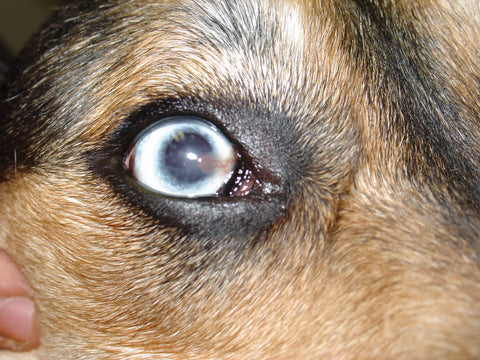If you’ve talked to us on the phone or run into us out in the dog world, you probably already know our boy Tuckerman was diagnosed with pannus four years ago. We were heartbroken over the thought of leaving him inside, and we figured there had to be something we could do to protect his eyes, and – long story short – Rex Specs was born. After developing a product that dramatically improved Tuck's day-to-day situation, it’s been a passion of ours to help other dog owners not let pannus take its toll on a loyal companion’s quality of life.

What is Pannus?
So first of all, what is pannus? Pannus (Chronic Superficial Keratitis) is an immune system condition that occurs as a result of ultraviolet (UV) light damage to the side of the cornea – the clear part of the eye – that triggers the body to attempt to repair the damage by sending small blood vessels into the layers of the cornea. Since the cornea doesn’t normally have blood vessels, the dog’s immune system assumes they may be harmful to the body, so the subsequent immune system reaction is to attempt to destroy the corneal tissues.
What all this science talk means is that without treatment, scar tissue begins to develop, and that can ultimately lead to severe visual impairment and blindness.
Pannus is most often found in German shepherds, Border Collies, Huskies, Australian shepherds, Long-Haired Dachshunds, and Greyhounds, but it can be found in any breed – especially in dogs who live and exercise at higher elevations.
Dr. Steve Roberts, a veterinary ophthalmologist based in Loveland, Colorado, who treats over 700 dogs every month for eye conditions, says the first thing to look for is “cloudiness on the very lateral edge of the cornea, and not only is it cloudy gray, but there’s also little tiny blood vessels in it.” If you look directly at a dog’s face, these early symptoms will show at the 3 o’clock and 9 o’clock positions on the outside of the dog's eye.

Is There a Cure for Pannus?
Sadly, there’s no cure for pannus – but the good news is that it’s a treatable disease. Vets most commonly prescribe eye drops, such as dexamethasone, prednisolone, or cyclosporine, to treat it. The earlier you catch this condition, the less chance there is for scar tissue or severe impairment to occur.
SHOP UV400 PROTECTIVE DOG GOGGLES>>
In addition to the eye drops, reducing your dog's exposure to UV rays is the most important factor. Dr. Roberts sees a direct connection between pannus severity and the amount of UV light dogs are exposed to each day, especially during summertime. In the winter, he sees an average of 2-4 cases of pannus each month, but between the end of May and September, he treats 6-8 cases every week. “Where I’m at in Colorado, the elevation is over 5,000 feet, and a lot of the dogs I deal with are up on the weekends at 7,000-10,000 feet,” he said. “So that has a huge impact, and their treatment can be really difficult to manage. I’ve had people relocate to much lower elevations, and the pannus that was hard to control in Colorado is now very easy to control at elevations less than 1,000 feet."

Unfortunately, for so many of us, we can’t imagine relocating away from the mountains that we (and our dogs) love so much. The other option Dr. Roberts and many other vets are now recommending for reducing exposure to UV rays to keep pannus contained is to get your dog in a pair of Rex Specs.
How Can I Protect My Dog From Pannus?
Rex Specs are not a substitute for the eye drops, but the lenses are rated UV400 to provide protection from 99-100% UVA/UVB rays to keep the condition from getting worse. We’ve personally seen great success in getting Tuck’s pannus under control by having him in Rex Specs when we're outside. Now we’re on a mission to make sure every dog owner knows the signs of pannus and how to best manage it, and we’d love for you to help us spread the word so all of us can enjoy life to its fullest with our best buds.

Tuck happy and healthy living an outdoor life!
Pannus isn't the only eye condition that warrants the use of eye protection. Exposure to UV rays, especially during summer months, can cause some dogs' eyes to sunburn or be more sensitive to the sun. Rex Specs lenses are all UV protected, so you can rest safely when using them. To read another interview by two of our ambassadors who venture out hiking often with their dog, take a look at this blog post.
If you're looking to find out more about pannus, here's a few starting points:

